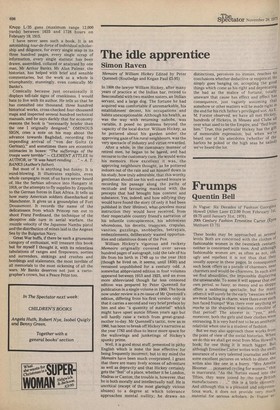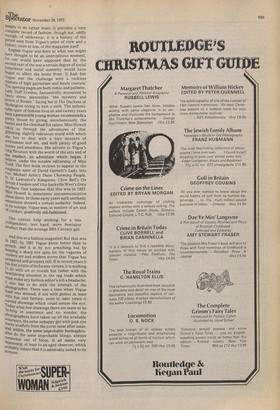Frumps
Quentin Bell
In Vogue: Six Decades of Fashion Georgina Howell (Allen Lane £12.00 from February 1st. £9.75 until January 31st, 1976). 20th Century Fashion Ernestine Carter (EYre Methuen £3.75) These books may be approached at several levels. Both are concerned with the clothes of fashionable women in the twentieth centurY. neither is concerned with men. And although fashionable women are, as often as not, old. ugly and repellent it is not thus that they usually appear in these pages. In consequence each book offers us a parade of charmers, near charmers and would-be-charmers. In each ala° we find absurdities, the impossible displaYIng the unwearable. To some it will appear that our own period, so fussy, so messy and so slopPY offers a saddening spectacle; but for alan,Y others it will surely be the early 'twenties which are most lacking in charm; were there ever such bun faced frumps? Was there ever anything s° moche as the shapeless waistless crinoline of that period? The answer is: "yes," and' moreover, both the girls and their clothes were entrancing. It is very hard not to be an aesthetic relativist when one is a student of fashion.
But we may also approach these works from the point of view of the social historian. When we do this we shall get most from Miss Howell book; for one thing it is much bigger. But although Ernestine Carter writes with the swift assurance of a very talented journalist and has some excellent pictures on which to dilate. she writes also like one in a hurry. "Mrs Ameha Bloomer. ... pioneered cycling for women," this is inaccurate. "As the 'forties eased into the 'fifties, they were joined by the top. British manufacturers . . .," this is a little slovenlY. And although this is a pleasant and unpretentious work, it does not provide very much material for serious scholars. In Vogue at" tempts to do rather more; it provides a very complete record of fashion, though not, oddly enough, of underwear; it is a history of the Period seen from Vogue's point of view and a history, more or less, of the magazine itself. English Vogue was born at what one might have thought to be an unpropitious moment, for one would have supposed that by the second year of the war a certain degree of social conscience and social austerity would have begun to affect the home front. It had; but Vogue met the challenge with a reckless haxture of high patriotism and haute couture: The opening pages are both comic and pathetic, Lady Duff Gordon, fantastically accoutred in fancy dress, personifies "the mystery and Power of Russia:" facing her is The Duchess of Wellington trying to knit a sock. The indomitable spirit of fashion lives on and twenty years later a personable young woman recommends a Pretty blouse by giving, simultaneously, the fascist and the clenched fist salute. Miss Howell takes us through the adventures of that glittering, slightly ridiculous world with which she has to deal with a nice mixture of senousness and wit, and with plenty of good stories and anecdotes. She adverts to Vogue's long flirtation with the world of the arts and of the intellect, an adventure which began, I believe, under the notable editorship of Miss Todd. The first book reviews to appear in the magazine were of David Garnett's Lady into Fox, Michael Arlen's These Charming People, 1).. H. Lawrence's Kangaroo, Clive Bell's On British Freedom and Vita Sackville West's Grey Wetiters, One supposes that this was in 1923; Miss Howell is sometimes uncommunicative about dates. In those early years such aesthetic e. xcursions showed a certain audacity. Indeed, in its nonage, Vogue was, in matters of art and of conduct, positively old-fashioned.
One cannot help wishing for a less independent, less hard, more feminine Product than the average 20th Century girl.
And this in a fashion magazine! But that was in 1921; by 1931 Vogue knew better than to Preach, and it is by not preaching but by keeping a sharp eye open for the vagaries of modern art and modern mores that Vogue has Prospered and prospers still. If in recent years it has lost a little of its former virtues, it is nothing to do with art or morals but rather with the bewildering situation in the rag trade which Must make any fashion editor's job a headache; it also has to do with the triumph of the Photographer. There was a time when Vogue itself was dressed, if not with genius at least With fun and fantasy; even in later years it carried drawings which could amuse the eye. Today what few drawings there are seem to be lacking in assurance and no wonder, the Photographers have taken up all the available assurance, the same unhappy girl with pink eye stares woefully from the cover issue after issue, and, within, the same improbable hermaphrodites do the same improbable things, always somewhat out of focus. It all seems very dePressing, at least to an aged observer, which Probably means that it is admirably suited to its PorPose.



































 Previous page
Previous page